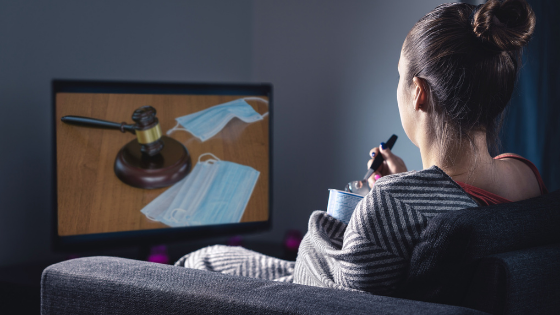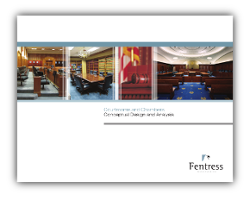The 2020-21 TV season has started, and it’s interesting to see to how TV dramas are dealing with the COVID-19 pandemic in their fictional worlds. From my standpoint as a court design consultant, I’m especially interested in the TV shows that involve courtroom scenes, and what COVID protocols those TV court proceedings are following. Mostly, I’m curious about how well art is imitating life. But I also wonder if real life can learn something from the ideas we see on TV.
Necessity is the mother of invention, and this pandemic has necessitated both real-life courts and their fictitious TV counterparts to find inventive ways to deal with preventing the spread of the virus in a courthouse. Here are a few ideas as seen on TV, both borrowed from reality and made up for dramatic purposes.
Communicate the Protocols
The CBS series Bull is one show that is tackling the effects of COVID on the court process. The show is about a trial jury consultant, so a large part of each episode takes place in a courtroom and revolves around the court proceedings. In a recent episode involving a jury trial, the judge took time to read a prepared statement laying out for everyone involved what to expect, and what is expected of them, regarding COVID protocols in her courtroom. Here’s what she said:
“Just so everybody understands how the COVID of it all works in my courtroom, I am behind plexiglass and I am socially distanced from everyone, so please don't let the fact that I am not wearing a mask cause you any concern. Witnesses are also seated behind plexiglass and are socially distanced. We feel it's important for the jurors to see their entire faces."
I understand and agree with the idea that the witness face needs to be seen by the jurors. Body language and facial expressions are an important factor in the ability for a juror to fully take in what the witness is saying, so the testimony can be weighed by the juror. It’s also important for the litigants and attorneys to be able to see the face of the witness.
Whether the judge should be wearing a mask is best left up to each jurisdiction. But, hey – it’s a TV courtroom drama. Would TV viewers want to see a key player in a drama wearing a mask all the time? The statement made by the show was that the judge was modeling and communicating some of the necessary precautions, while explaining how the judicial process was still being upheld.
The fictitious TV judge went on to further explain the rules for the rest of the participants:
“Jurors are behind plexiglass and are required to wear masks because even though they are socially distanced, they are in a congregant group. And we are determined to keep them as safe as is humanly possible.
“As for the defense and plaintiff tables, whether or not you wear a mask is totally up to you and your clients. You are far enough away that proximity should not pose an issue. The only other rule for you is no more than two people at the table...presumably, the principal attorney and the client.”
Remote Jury(?)!
Another episode of Bull centered on COVID protocols involving juries. The show’s main character, Dr. Jason Bull (aka Bull), is a psychologist whose specialty is helping lawyers understand the human nature side of juries by studying individual jurors during voir dire and by analyzing their body language during proceedings.
In the first episode this season, Bull was preparing for his first case since COVID restrictions had been implemented in the courthouse. He was horrified to learn that jurors would not be present in the courtroom, neither for voir dire nor for the actual proceedings. Instead, the jury would be in a separate room, and would only interact with the court via audio and a one-way video. Bull would not be able to see the jurors and read their body language, hampering his ability to do his job.
However (spoiler alert!), it all turned out to be a bad dream – literally. Bull had contracted the virus, and this nightmare scenario for him was actually just a dream brought on by his fever. Once Bull recovered and went back to work at the courthouse, he was relieved to learn that jurors would be present in the courtroom – albeit with face masks.
Whether or not we agree on the need for a jury consultant like Dr. Bull, I think most would agree that – for the jury’s sake – having the jury present in the courtroom to be able to view the proceedings firsthand is an important part of our justice system. Maybe video presence will be advanced enough for jurors to one day get the immersive experience necessary to properly fulfill their duty remotely, but for now in-person, in-courtroom juries are a must.
However, this raises another dilemma. How can the jurors socially distance themselves from one another in the courtroom during a trial? Another TV show that centers around a courthouse addresses this.
Spread Out the Jury
The TV series All Rise (also on CBS) is about recently-appointed Los Angeles County Superior Court Judge Lola Carmichael. The show is a great example of how fictional TV courts have taken COVID protocols seriously and embraced them as an integral part of the drama.
In a recent episode, Judge Carmichael (like Dr. Bull) was embarking on her first jury proceedings since COVID protocols were put in place. Along with masks and plexiglass screens, her court decided to further protect jurors by taking up more of the existing real estate in the courtroom. They placed some jurors in the jury box and some in the spectator gallery. The public was seated in another courtroom where they could view the proceedings on closed-circuit TV.
I think this is a great solution, similar to one I had mentioned in a previous blog on adapting courtrooms for COVID, in which the entire gallery was used to seat all jurors and the jury box was used as a witness stand.
All Rise went further than Bull did by installing plexiglass screens between the litigants’ tables and between each person at the table. Lawyers and litigants wore masks in the courtroom and only removed them to speak. Other forms of protection portrayed on the show included plexiglass screens around office desks (such as in the judges’ chambers and District Attorney’s office), mask-wearing in the courthouse hallways, and distancing inside of court offices.
Virtual Jury Orientation
Another idea shown during the All Rise episode was the use of videoconferencing for juror orientation. Judge Carmichael, who was conducting the orientation, sat on her bench and had two large video monitors in front of her, each screen with about 25 jurors sitting in their homes, like a Zoom conference.
One thing that occurred to me while watching this is that some prospective jurors may not have adequate technology for a videoconference, or may not be able to effectively use the technology. I wondered if this could result in a jury pool that does not represent a true cross-section of citizens.
However, after doing some more research on virtual orientations, I discovered that, in most cases, jurors have the option to participate by video or by phone. In some cases, appearing in person at the courthouse was also an option. These solutions make the jury orientation process both safe and inclusive.
Art Imitating Life; Life Taking Lessons From Art
While it seems the vaccine rollout for all is on the horizon, it will still take some time for our way of life, including courthouse operations, to get back to “normal.” However, even after the world does resume some sense of normalcy, I think some of the ideas devised by both real-world courts and TV-drama courts could be adopted as a permanent change moving forward. These provisions, along with pre-existing activities such as expanding mediation and increasing the use of video proceedings, will help reduce traffic in already-overburdened courthouses. And this may be the architect in me speaking, but I think the changes could usher in a new era in courthouse design.
_________________________________________________________
Click on the image below for our eBook on courtrooms and chambers





.jpg)
.jpg)
.jpg)
.jpg)
.jpg)
.jpg)


.jpg)
.jpg)
-1.jpg)
.jpg)
.jpg)
.jpg)
.jpg)
.jpg)

